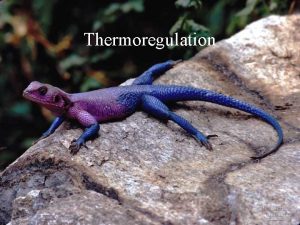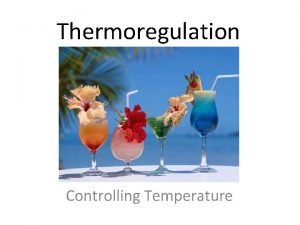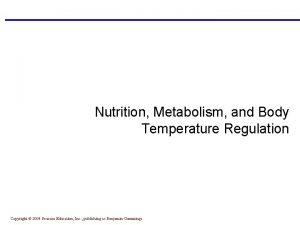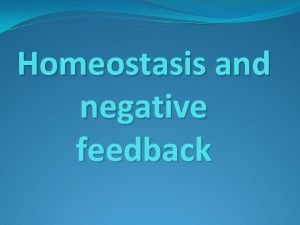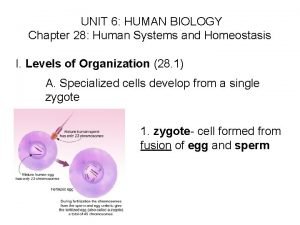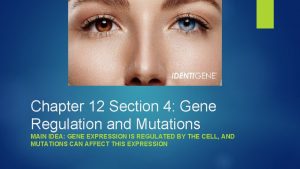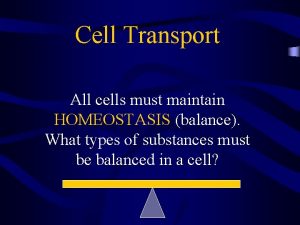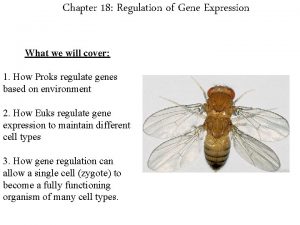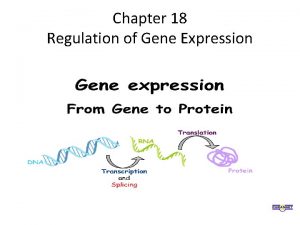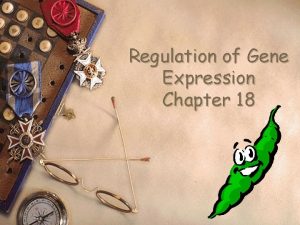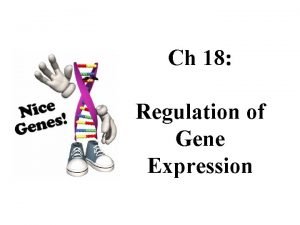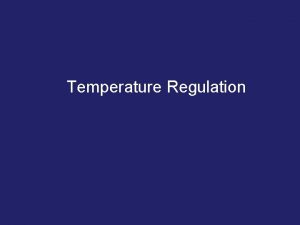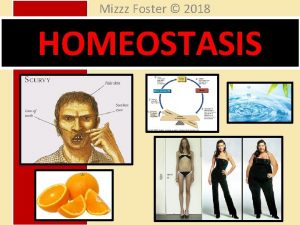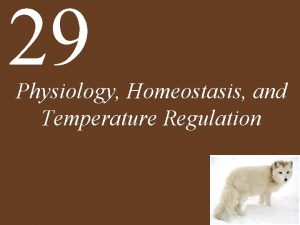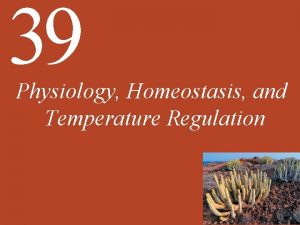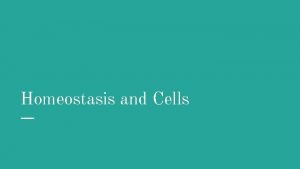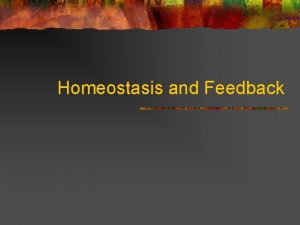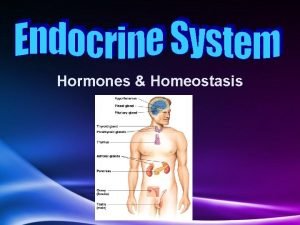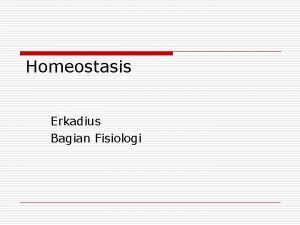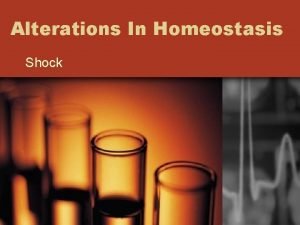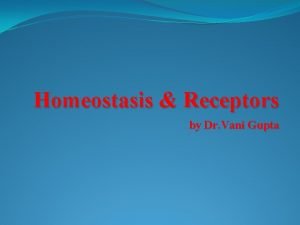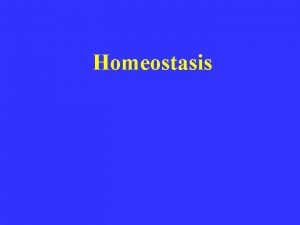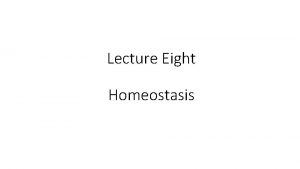Chapter 29 PHYSIOLOGY HOMEOSTASIS AND TEMPERATURE REGULATION PHYSIOLOGY




































- Slides: 36

Chapter 29 PHYSIOLOGY, HOMEOSTASIS, AND TEMPERATURE REGULATION

PHYSIOLOGY: INTERNAL FLUIDITY � Animals are mostly water � Intracellular Fluid (ICF) � Most of water � Within cells � Extracellular � The Fluid (ECF) rest of the water, interstitial fluid, plasma, lymph � Interstitial fluid: Bathes cells, nutrients, waste

PHYSIOLOGY: HOMOESTASIS � Homeostasis � Maintaining stable internal environment � Temperature, p. H, ion concentration

PHYSIOLOGY: TISSUES � Cells → Tissues → Organs � Specialized cells form tissues � Tissue types � Epithelial � Connective � Nervous � Muscle

PHYSIOLOGY: EPITHELIAL TISSUE � Epithelial cells � Lines body surfaces and organs � Functions � Secretion, selective absorption, protection, transcellular transport and detection of sensation

PHYSIOLOGY: CONNECTIVE TISSUE � Components: Cells, fibers, extracellular matrix � Functions � Store energy, protect organs, provide structural framework, connect tissues � Tissue composition differs based on function

PHYSIOLOGY: NERVOUS TISSUE � Composed of two cell types � Neurons � Conduct nerve impulses throughout body � Components of central and peripheral nervous systems � Communicate by chemical neurotransmitters � Glial � Provide support for function

PHYSIOLOGY: MUSCLE TISSUE � Function: produce force and create motion � Contractile filaments move across � Changes size of cell → Motion � Three types � Skeletal: Locomotion and movement � Cardiac: Heartbeat � Smooth: Forces in internal organs

PHYSIOLOGY: ORGANS � Cells → Tissues→ Organs � Most organs have all four tissue types � Homeostasis depends on organs responding to the demands of the cells

PHYSIOLOGICAL REGULATION ACHIEVES HOMEOSTASIS � Information is required to regulate internal environment. � Information=Feedback � Systems are controlled by actions of nervous and endocrine systems

FEEDBACK INFORMATION � Set point � Desired � Error � Any level or rate signal difference between the set point and the feedback information

REGULATORY SYSTEM � Anything that receives information processes it and issues commands � Sensor-provides feedback information; eyes, nose, touch, hairs, etc. � Effectors-systems that make the changes

NEGATIVE FEEDBACK � Most commonly used by regulatory systems � “Negative”- used to counteract a force pushing away from the set point, the change is “negated” � Ex: Sweating from your body temperature being to high cools you down.

POSITIVE FEEDBACK � Not as commonly used as negative feedback � Amplifies a response � Increases � Sexual the deviation from the set point behavior- a little stimulation causes an increased behavioral response

FEEDFORWARD INFORMATION � Information used to change a set point � Ex: Squirrels know when cold temperatures are coming, and use this information to change the regulations and hybernate


LIVING CELLS ARE TEMPERATURE SENSITIVE � Normal cellular function=0 -40 degrees C � Most cells adapted to narrow limit � Humans- 35 -40 Degrees C

TEMPERATURE SENSITIVITY � Most reactions are temperature sensitive � Usually proceed faster at a higher temperature Q 10 = RT/RT– 10 Q 10 –temperature sensitivity coefficient RT –rate of reaction at a certain temperature Also known as “the 10 degree rule”

ACCLIMATION TO SEASONAL TEMPERATURES � Produce fewer enzymes � Produce enzymes with different optimal temp

REGULATION OF BODY TEMPERATURE � Ectotherms � “heat from the outside” � Use heat from the environment � Invertebrates, Fish, Amphibian, Reptiles

REGULATION OF BODY TEMPERATURE � Endotherms � “heat from inside” � Maintain a higher body temperature � Heat generated metabolically � Birds and Mammals


TEMPERATURE REGULATION � Heat budget equation � Heatin: Thermal energy flowing in � Environment � Heatout: � If and metabolism Thermal energy leaving animal heatin ≠ heatout, then body temperature will change � Surface area and temperature are key factors

THERMAL ENERGY GAIN/LOSS � Metabolism � Cleaving bonds in ATP � Radiation � Infrared radiation � Convection � Conduction � Evaporation

TEMPERATURE REGULATION � Endotherms spend more energy pumping ions across membranes and maintaining concentration gradients � Expenditure of energy releases heat

TEMPERATURE REGULATION � If temperature falls below endotherms lower critical temperature, then their body temperature will fall � Heat produced by � Shivering thermogenesis � Nonshivering heat production in brown fat

TEMPERATURE REGULATION � Basal metabolic rate (BMR) � � Body size and environmental temperature Increases as animals get smaller

TEMPERATURE REGULATION � Cold-climate species � Lower surface area/volume ratio � Insulation with fur � Decrease blood flow to skin � Countercurrent heat exchange � Rounder body shapes have lower ratio

TEMPERATURE REGULATION � Fish lose most heat as blood travels through gills � Cold fish use cold blood from gills � Hot fish use countercurrent exchage

TEMPERATURE REGULATION � High environmental temperature � Increased blood flow to skin � Evaporation of water through sweating � Active process

TEMPERATURE REGULATION � Ectotherms � Insects can produce heat contract flight muscles

TEMPERATURE REGULATION � Endotherms and ectotherms both regulate temperature behaviorally


TEMPERATURE REGULATION � Hormonal and neural mechanisms control thermoregulatory adaptations � Temperature regulatory system acts as thermostat � Hypothalamus is the center of thermostat

TEMPERATURE REGULATION � Cool hypothalamus � Increased metabolic rate � Less blood flow to skin � Warm hypothalamus � More blood flow to skin � Sweating and panting � Negative feedback

TEMPERATURE REGULATION � Fever response to pathogens � Animals lower temperature during inactive periods- torpor � Energy conservation � Hibernation � Long lasting regulated hypothermia
 What animals are cold blooded
What animals are cold blooded Vasoconstriction heat loss
Vasoconstriction heat loss Thermoregulation
Thermoregulation Negative feedback mechanism
Negative feedback mechanism Bioflix activity homeostasis hormones and homeostasis
Bioflix activity homeostasis hormones and homeostasis Bioflix activity homeostasis high blood glucose
Bioflix activity homeostasis high blood glucose Environmental considerations pdhpe
Environmental considerations pdhpe Difference between curie temperature and neel temperature
Difference between curie temperature and neel temperature Difference between curie temperature and neel temperature
Difference between curie temperature and neel temperature Difference between antiferromagnetism and ferrimagnetism
Difference between antiferromagnetism and ferrimagnetism Physiology of body temperature
Physiology of body temperature Chapter 28 human systems and homeostasis
Chapter 28 human systems and homeostasis Section 4 gene regulation and mutations
Section 4 gene regulation and mutations Homeostasis evolution
Homeostasis evolution Homeostasis examples
Homeostasis examples Homeostasis and cell transport
Homeostasis and cell transport Chapter 18 regulation of gene expression
Chapter 18 regulation of gene expression Chapter 18 regulation of gene expression
Chapter 18 regulation of gene expression Chapter 18 regulation of gene expression
Chapter 18 regulation of gene expression Chapter 18 regulation of gene expression
Chapter 18 regulation of gene expression Chapter 14 anatomy and physiology
Chapter 14 anatomy and physiology Waistline
Waistline Anatomy and physiology chapter 8 special senses
Anatomy and physiology chapter 8 special senses Chapter 13 anatomy and physiology of pregnancy
Chapter 13 anatomy and physiology of pregnancy Chapter 2 basic chemistry anatomy and physiology
Chapter 2 basic chemistry anatomy and physiology Heat and cold
Heat and cold Anatomy and physiology coloring workbook chapter 14
Anatomy and physiology coloring workbook chapter 14 Chapter 10 blood anatomy and physiology
Chapter 10 blood anatomy and physiology Anatomy and physiology chapter 15
Anatomy and physiology chapter 15 Anatomy and physiology chapter 1
Anatomy and physiology chapter 1 Holes anatomy and physiology chapter 1
Holes anatomy and physiology chapter 1 Anatomy and physiology chapter 15
Anatomy and physiology chapter 15 Medial lateral distal proximal
Medial lateral distal proximal Chapter 2 human reproductive anatomy and physiology
Chapter 2 human reproductive anatomy and physiology Pectoral girdle acetabulum
Pectoral girdle acetabulum Chapter 6 general anatomy and physiology
Chapter 6 general anatomy and physiology Cephalic cranial
Cephalic cranial
